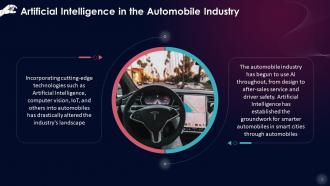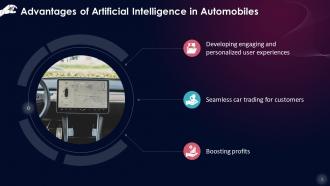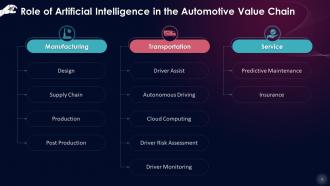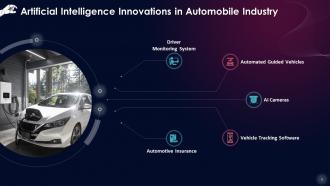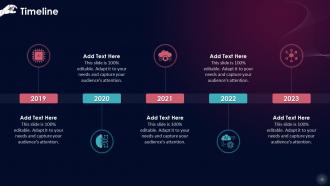Role Of AI In Automotive Innovation Training Ppt
These slides give an overview of how AI is helping to revolutionize the automotive industry. High-tech automotive firms have begun to employ cutting-edge technologies such as AI to compete in the market while providing the highest level of customer satisfaction. AI helps develop engaging and personalized user experiences, provides seamless car trading for customers, and boosts business profits.
You must be logged in to download this presentation.
PowerPoint presentation slides
Presenting Role of AI in Automotive Innovation. These slides are 100 percent made in PowerPoint and are compatible with all screen types and monitors. They also support Google Slides. Premium Customer Support available. Suitable for use by managers, employees, and organizations. These slides are easily customizable. You can edit the color, text, icon, and font size to suit your requirements.
People who downloaded this PowerPoint presentation also viewed the following :
Content of this Powerpoint Presentation
Slide 1
This slide gives an overview of how AI is helping to revolutionize the automotive industry. High-tech automotive firms have begun to employ cutting-edge technologies such as AI to compete in the market while providing the highest level of customer satisfaction.
Slide 2
This slide lists the benefits of the impact of Artificial Intelligence on the automobile industry. AI helps in developing engaging and personalized user experiences, provides seamless car trading for customers, and boosts business profits.
Instructor’s Notes:
- Developing engaging and personalized user experiences: Driver assistance technology, commonly used in vehicles today, relies heavily on AI. It successfully monitors a driver's eye, detecting whether or not the motorist is sleepy or sleeping. The AI in the car learns everything about the driver's preferred temperature setting, favorite songs, and navigational preferences to make traveling more fun, intuitive, and stress-free
- Seamless car trading for customers: AI is not restricted to automobile manufacturing and delivering superior user experiences, it also makes consumers' car buying and selling process extremely easy. In the future, AI-enabled interface systems will be able to recommend the best cars to customers based on their driving skills, insurance, health data, penalties, and other factors. In addition, next-generation vehicles will be able to get real-time information on traffic congestion or any other emergency and use AI to build high-resolution 3D representations of actual roadways
- Can help in boosting profits: Artificial Intelligence has the potential to help automakers stop losing money. In the short run, taking advantage of the increasingly advanced levels of data on vehicles, parts usage, and driving behaviors will be critical. Machine Learning and data science are essential technologies enabling flexible demand planning techniques and optimizing cost savings
Slide 3
This slide showcases the applications that Artificial Intelligence has in the automotive industry. AI is currently being used in areas such as design, supply chain, production, and post-production. Furthermore, AI is being used in 'driving assistance' and 'driver risk assessment' systems, which is revolutionizing the transportation industry. It is also making waves in the aftermarket services such as predictive maintenance and insurance.
Slide 4
This slide lists types of innovations based on Artificial Intelligence in the automobile industry such as 3D printers, smart helmets, autonomous vehicles, machine vision, and collaborative robots.
Instructor’s Notes:
- 3D Printers: 3D printers are used in the automotive sector to make fitness prototypes, visually pleasing parts, and efficient car models, among other things. Fused Filament Fabrication (FFF), employed in the automobile industry for manufacturing end-use parts, is one of the critical technologies underpinning 3D printers
- Smart Helmets: Driver safety is one of the top priorities and smart helmets are among the most important AI innovations in this industry. Drivers prefer smart helmets because of the modern technology that allows them to summon an ambulance or a family member in an accident. It also includes other features such as operating vibration sensors, alcohol sensors, collision alarms, LED lights, etc
- Autonomous Vehicles: High-tech giants are attempting to mass-produce self-driving cars all around the world. Without a human driver in the driver's seat, AV can perceive the surrounding environment and drive on its own. The ability to wander freely and independently in the city is beneficial to senior citizens
- Machine Vision: A Machine Vision System (MVS) is an AI technology that enables a computer to inspect, evaluate, and recognize static or moving images. It's a branch of computer vision similar to surveillance cameras but allows for automatic image capture, evaluation, and processing. It is critical for optimizing value chain operations such as quality assurance, production, logistics, and others. Machine vision is being used in the automotive sector to recognize specific objects, speed up existing production processes, and eliminate any errors or dangers, among other things
- Collaborative Robots: With their sophisticated features such as machine loading, machine tending, inspection, assembly in factories, and many more, collaborative robots, or cobots, are thriving in this business. Cobots collaborate with human employees to improve outcomes, consistency, flexibility, and assistance while reducing human error
Slide 5
This slide lists types of innovations based on Artificial Intelligence in the automobile industry such as driver monitoring systems, automated guided vehicles, AI cameras, vehicle tracking software, and automotive insurance.
Instructor’s Notes:
- Driver Monitoring System: Driver monitoring systems are quickly becoming one of the most popular AI advancements in preventing catastrophic road accidents by notifying drivers during tiredness, distraction, and other factors. It's also known as driver state sensing, and it uses a dashboard-mounted high-tech camera with infrared LEDs to track drivers' eye movements
- Automated Guided Vehicles: AGVs have begun to provide many benefits to the automotive sector, including lower direct labor costs, elimination of manpower shortages, reducing errors, restricting heavy products handling, scalability, increased productivity, improved safety, etc.
- AI Cameras: Integrating AI cameras in vehicles has enhanced the automobile industry's revenue. Drivers choose cars with AI cameras to ensure the safety of themselves and their loved ones. With a multi-path approach and the use of AI for image or video recognition, these AI cameras provide many services to drivers, making roads significantly safer
- Vehicle Tracking Software: The motor industry has recognized the relevance of vehicle tracking software in locating a car efficiently and effectively. The GPS is configured to offer real-time updates on a vehicle's location and condition
- Automotive Insurance: In the smart automobile sector, automobile insurance is critical. Drivers can estimate their own auto damage for their insurance providers
Slide 6
This slide lists the projected growth of Artificial Intelligence in the Automotive Industry. The AI in Automotive Market was valued at over $1 billion in 2019 and is expected to expand at a 35% Compound Annual Growth Rate (CAGR) between 2020 and 2026.
Instructor’s Notes: Artificial Intelligence in the automobile industry is predicted to cause significant upheaval by improving production capabilities and enhancing company growth. The development and implementation of novel technologies like autonomous mobility, car simulations, rapid prototyping, and AI-enabled automotive manufacturing gives the autonomous technologies sector a bright future. Automakers are rapidly adopting AI platforms into their existing production systems and are focusing on developing autonomous vehicles to improve passenger mobility.
Role Of AI In Automotive Innovation Training Ppt with all 22 slides:
Use our Role Of AI In Automotive Innovation Training Ppt to effectively help you save your valuable time. They are readymade to fit into any presentation structure.
-
I loved the hassle-free signup process. A few minutes and, I had this giant collection of beautiful designs.
-
I didn’t expect such a good service for the money I am paying. But, they exceed my expectations. Great work SlideTeam.
























